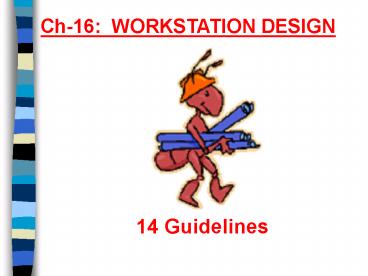Chapter 6: Value Engineering PowerPoint PPT Presentation
1 / 16
Title: Chapter 6: Value Engineering
1
Ch-16 WORKSTATION DESIGN
14 Guidelines
2
Outline
- Avoid Static Loads and Fixed Work Postures
- Reduce Cumulative Trauma Disorders (CTD)
- Set Work Height at 50mm Below the Elbow
- Furnish Employees with Adjustable Chair
- Use the Feet as well as the Hands
- Dont Oppose Gravity Use it.
- Conserve Momentum
3
Outline (cont.)
- Use Two-Hand not One-Hand Motions
- Use Parallel Motions for Eye Control of 2-Hand
- Use Rowing Motions for Two-Hand Motions
- Pivot Motions About the Elbow
- Use the Preferred Hand
- Keep Arms in the Normal Work Area
- Let the Small Woman Reach the Large Man Fit
4
I) Avoid Static Loads and Fixed Work Postures
Cardiovascular Effects
- Standing
- - Anatomy
- - Physiology
- - Shoes
- - Floors
- Falls
- - Problem
- - Causes
- - Solutions
- Sitting
- Head / Neck
- Hands / Arms
5
Avoid Static Postures
- Employees should be encouraged to wear proper
shoes for work req. lots of standing - Workstations should be equipped with mats
- Jobs need to be designed to allow the
three-contact rule for climbing stairs, or better
yet, use a ramp - Make sure walking surfaces prevent slips falls
- Keep the line of sight below horizontal
- Keep arm position low
6
II) Reduce Cumulative Trauma Disorders
See Table 16.4
III) Set Work Height 50mm Below Elbow
- Optimum Height
- - Manipulative Work 50mm below elbow
- - Applies when sitting or standing
- Solution Techniques
- - Change Machine Height
- - Adjust Elbow Height
- - Adjust Work Height on Machine
7
IV) Furnish Every Employee with an
Adjustable Chair
- Justification / Selection
- Chair Design
- Non-Chair Alternatives
- Seating Posture Variability
8
Chair Design Considerations
- seat height from floor
- seat length
- seat width
- slope of seat
- seat shape
- position of backrest
- molded chair back position curvature
- clearance of feet and calves under chair
9
V) Use the Feet as Well as the Hands
- Power
- Control
VI) Use Gravity
Dont Oppose It
- Body
- Work
10
Use the Foot when Possible
- Consider adding foot control pedals instead of
only hand controls, but only on seated jobs - Legs have more strength
- Feet move slower than hands
- Gravity can help here too
11
VII) Conserve Momentum
- Stirring and Polishing Motions
- Baking, Flour Making, Polishing
- Disposal Motions
- Improve performance, minimize
- Acceleration/Deceleration deviations
- Grasping Motions
- Improve grasping can Min. Accel/Decel
- Transport Motions
- Extra time extra effort to transport weight
12
VIII) Use 2-Hand Motion Not 1-Hand
- Human Power
- How much can you pull?
- Manipulative Work
- Use guides for precise locations A Hand is NOT
- a fixture. Two hands take more effort and time
- Holding
- A part with 1 hand high static load reduce
- productivity
Use a Clamp - Saves time SPP 4 months
13
IX) Use // Motions for Eye Control of
2-Hand Motions
- Arms Motions in Opposite Symmetrical Dirs.
- should be Symmetrical
- Eyes fixation As few close as possible
- // vs symmetrical motion the MTM case
X) Use Rowing Motions for 2-Hand Mtns.
- Rather than alternating motions
14
XI) Pivot Motions About The Elbow
- Horizontal Moves Direction at a Height
- Movement Speed - Accuracy - Psychological Cost
- TIME Elbow pivoting lt cross-body moves
XII) Use The Preferred Hand
- Dominant Hand 10 faster and more accurate
- Dominant Eye Your shooting Eye
- Work Flow to W.Station From Ops. Preferred
- side leaving through non-preferred
side
15
XIII) Keep Arm Motions In Work Area
- Elbow Height see Figure 16.28
- Use reaching aids or workstation cutouts to
increase range - Normal Work Areas see Figures 16.29 and 16.30
- Reach at All Heights see Figure 16.28
- Sitting or Standing ? Depends
- Arm pivoting Elbow vs Shoulder
- Examples Circuit Board, Car Door Assembly
line - Also Dont forget to leave Toe Space in
- work area design
16
XIV) Let The Small Woman Reach
and the Large Mean Fit
- Design to allow most users to use the design 50
- In your Design Exclude as Few as Possible
- User Population
- - Women or Men Small vs Large Welding
- - Multiperson workstation WAFFLE House
- - Civilian vs Military All vs well fitted
- - International Workers
- Percent to Exclude
- - Lower Percentiles (short or weak)
- - Upper Percentiles (tall) see Figure
16.35 - - Both Lower Upper (Low High IQ)
X

